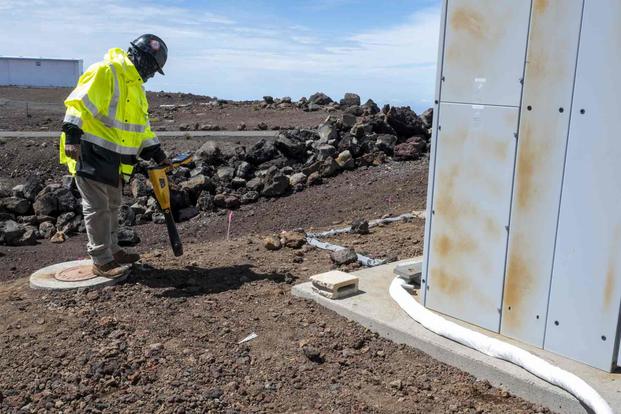Five months after a fuel tank at a Space Force observatory spilled 700 gallons of fuel atop a sacred Hawaiian volcano, officials are still trying to determine how much of the soil has been contaminated.
In the months since the fuel spill at a facility perched on the 10,023-foot summit of Haleakalā, a volcano on the Hawaiian island of Maui, the Department of the Air Force has been working on cleanup efforts with local and federal agencies. In that time, workers had removed an estimated 84,000 pounds of soil, but crews are still working to see how deep the fuel may have saturated into the ground.
"We are taking deliberate actions as we work to safely restore the sacred grounds at Haleakalā, while taking into account regulatory and cultural needs at the site," Lt. Col. Phillip Wagenbach, 15th Space Surveillance Squadron commander, said in a press release earlier this month.
On June 16, a contract was awarded to GSI Pacific, a Native Hawaiian-owned company, which will take soil samples at depths of 40, 80 and 100 feet in an attempt to build an underground "map of fuel contamination depth and breadth," according to a press release.
That work -- the second phase of the cleanup efforts -- was supposed to last for two weeks, but could face delays if there's inclement weather on Haleakalā. A Space Force spokesman said Thursday the efforts appeared to be on schedule.
Haleakalā is a culturally and religiously significant site for native Hawaiians, according to the National Park Service, and it is considered to be a dwelling for the gods and is a place where priests perform ceremonies.
The Space Force also hired Dane Uluwehiokalani Maxwell, a local born in Pukalani on the slopes of Haleakalā, to monitor the excavation and provide cultural advice. Maxwell's grandfather was a notable critic of the space telescopes' early development.
Maxwell told Military.com in a phone interview on Thursday that the progress was steady, but that there were sensitivities that needed to be taken into account with the sacred soil.
"It's going as good as it can for something that has impacted the culture pretty severely," Maxwell said. "I know a lot of new territory is being explored to try to accommodate and work with cultural concerns. It's been a process and is another good exercise; I just wish it wasn't at the expense of a diesel spill."
The spill was blamed on a diesel fuel pump for a backup generator that failed to shut off on the evening of Jan. 29, according to the Space Force. A float -- a piece that helps monitor fuel levels -- inside the fuel tank was defective, the service said.
The Jan. 29 spill was the latest incident that has marred relationships between Native Hawaiian groups and the Department of Defense. Nearly a month after the spill, Air Force Secretary Frank Kendall made a 5,000-mile trip from Washington, D.C., to the island and gave a speech saying the situation "harmed our reputation."
Maxwell acknowledged that there's a long history of protest against military construction and the presence of troops on the Hawaiian islands, with the fuel spill on Maui seen as another example of that strife.
"When it did happen, it was just, you know, 'Here's another instance of why we shouldn't have these facilities in our most sacred spaces,''" Maxwell said. "So, there's a lot of angry individuals."
The 700-gallon fuel spill at the Maui Space Surveillance Complex, which is home to the Defense Department's largest optical telescope, according to the Space Force's website, was only a fraction of the 20,000 gallons of jet fuel leaked in a much larger incident at the Navy's Red Hill Bulk Fuel Storage Facility near Honolulu in 2021.
At least 93,000 people living in military housing on and around Pearl Harbor were affected by the massive jet-fuel spill. More than 5,000 gallons eventually seeped into the ground and tap water.
That contamination forced thousands to leave their residences, and those who stayed had to rely on bottled water for months. In 2022, the Pentagon announced that the World War II-era bulk fuel farm would be closed and drained.
Brig. Gen. Anthony J. Mastalir, commander of Space Forces Indo-Pacific, told Military.com during the Air and Space Forces Association's conference in Colorado in March that the situation on Maui differed from Red Hill due to the fact that there are no residents and no water sources at the top of the volcano.
But Mastalir added it was still important to repair trust with the Hawaiian community and added, "You rebuild that relationship by spending time and you listening to the local people." He said he has spoken with protesters who have come to the site, as well as numerous community leaders.
"Haleakalā is a little bit different than the concern we saw in O'ahu with Red Hill; it's really more about the sacred land upon which we operate," Mastalir said. "Recognizing that that is a privilege, not a right, and recognizing that if the Space Force is going to continue to operate, that we're going to do so responsibly like we have done for the last 30 years."
-- Thomas Novelly can be reached at thomas.novelly@military.com. Follow him on Twitter @TomNovelly.
Related: Fuel Spill on Sacred Hawaiian Volcano 'Harmed Our Reputation,' Air Force Secretary Says










